A little over three decades ago, we moved into a newly constructed house on the outskirts of the city. At that time it was considered to be a location outside of town though there was a fair bit of civilization beyond this point. The house was built in the middle of a large open space. No compound wall proclaimed the boundary. Behind the house was an abandoned quarry, which had, over the years, filled with water and had come to support some aquatic vegetation.
As a youngster who was not even remotely interested in wildlife or natural history, it was a punishment to be living in this setting. I would complain frequently about the choice of location.
It was around this time that I was introduced to a hobby called “bird-watching”. I got hooked to this new found hobby after a couple of visits to some scrub jungle on the city outskirts. From this point onwards the transformation happened quite rapidly. And, I was all praise about the location of our home. There could not have been a better choice. Suddenly, the place seemed to have come alive and was full of life worthy of some attention for the curious.
Bird watching had now become a default preoccupation. Anything flying, be it a bird or a dragonfly, caught my attention. The wild growth in the open spaces supported a few birds and kept me busy for some time. But I quickly realised that the quarry could be good hunting grounds too.
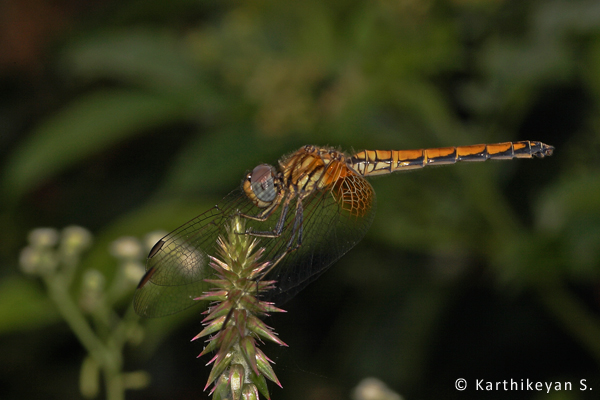
At first sight, all that would meet the eye was a lush green mat of grass with bulrush growing in a dense cluster near the edges and the shallows. The mat of grass was so dense that a light-weight human being could walk across the span of water without getting his feet wet! Some shrubbery adorned the edges of the quarry. This mosaic of vegetation created ample opportunities for a variety of birds to occupy this area. This, I discovered was a perfect place to watch birds.
The initial years of birding were without a pair of binoculars. This meant that I spent a lot of time observing birds to gather as many details so as to enable me to identify them. I would sit on a large rock that jutted into the quarry to do just this. Over a period, I managed to see several species that I had never seen before.
The first ones that caught my attention were the munias. I would see small flocks of these birds flying in and out of the quarry. I had to wait patiently because these birds would fly into the vegetation and be effectively hidden by it. One could see tall and slender rushes swaying due to the birds but waiting was inevitable to get a good look at them. Eventually, I got to see the Spotted Munia, the Blackheaded Munia, the Whitebacked Munia and the stunningly beautiful Red Munia. All of these with their conical beaks were beautifully adapted to feed on seeds. The ease with which these adorable little birds would balance on the tall bulrush was interesting to watch. On occasion, I have seen them carry nesting material indicating that they even nested amid the vegetation.
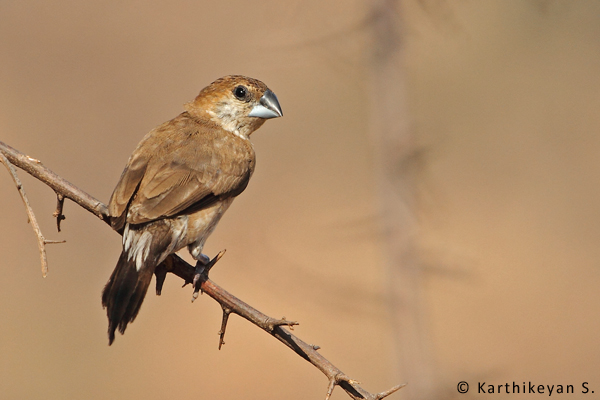
The Indian Silverbill was seen along with the other munias.
The Whitebreasted Kingfisher was a regular around the quarry. It was often seen perched on the electric pole and calling. This bird was very comfortable in the semi-urban setting since it could survive on a varied diet. I have seen them nest in deep burrows on the mud bank on one side of the quarry.
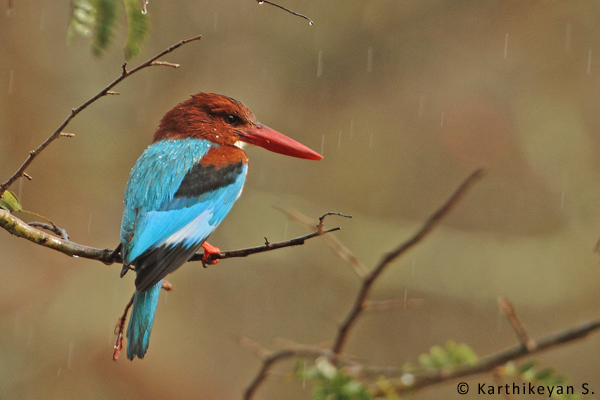
Whitebreasted Kingfisher – still holding on precariously.
The Whitebreasted Waterhen was a resident here. I would watch it as it went about finding food, venturing cautiously out of the tangle to the edge of the water. It could be seen walking about with measured steps. The erect tail twitching with each step was very characteristic. The calls of the bird during the breeding season was always heard and on one occasion I was lucky to see the entire family – the adult with two little chicks covered with sooty black down on tow. The Ruddy Crake was, however, much more shy and would stay within the maze of vegetation, seldom venturing out.
In the evenings it was always a pleasure to watch flocks of egrets fly past, particularly when the sky was a dark shade of grey with the evening light illuminating the vegetation and the egrets (both Cattle Egrets and the Little Egrets). Sometimes, they would descend on the mat of green before flying off to their regular roost elsewhere.
The Large Pied Wagtail would herald the mornings for me with its almost incessant call – a mixture of fluty rolling notes interspersed with shrill whistles. The call was uttered from atop the electric pole a little distance from our home.
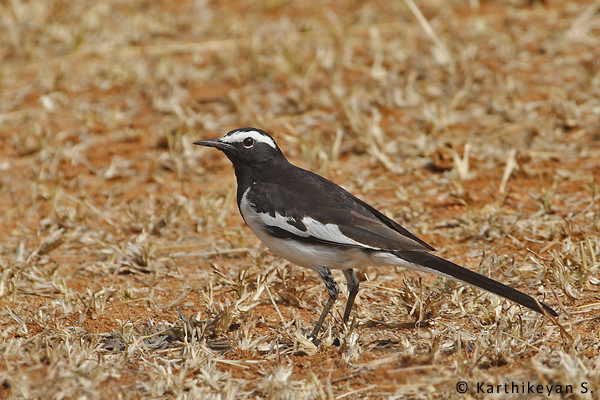
Large Pied Wagtail
The onset of winter was invariably announced by the Grey Wagtail. I would hear the calls much before I got to see the bird. For several years, one individual would visit the area exactly on the same date each year! I had no means to verify whether it was the same individual or not. The Brown Shrike, also a winter visitor, was a regular too. These birds probably staked out a territory and proclaimed it with the harsh grating calls uttered during the early mornings and evenings. Then of course the other common winter visitors to wetlands – Common Sandpiper and Green Sandpiper could be seen from time to time before they returned to their breeding grounds.
There were a few rarities too. And incidentally, all these were birds that I was seeing for the first time. The Pied Crested Cuckoo one evening, decided to visit the vegetation around the quarry and even settled on the reeds briefly.
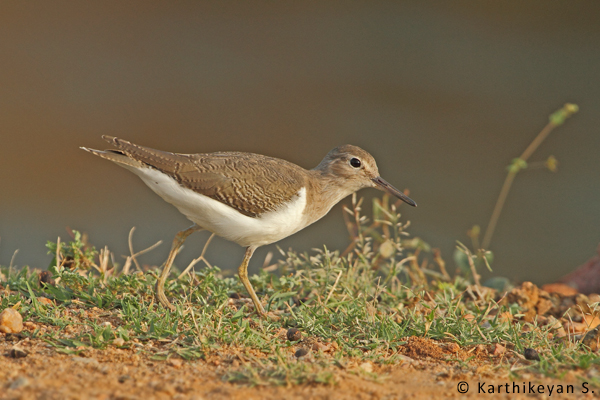
The migratory Common Sandpiper that was seen occasionally does not find the habitat suitable any longer.
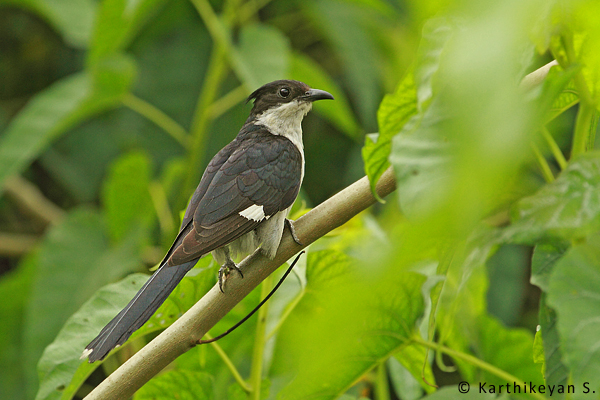
The Pied Crested Cuckoo.
A small flock of the rare Streaked Weavers decided to make the quarry their home for a few days. I was hoping to see them breed in the quarry. Sadly, it was not to happen and I did not get to see their nest. Most of us have seen the retort shaped nests built on a slender twig by the more common Baya Weaver. The Streaked Weaver too builds similar nests. But it is built by bringing together the tips of several reeds and the pendulous nest woven. The Bluethroat and the Black Redstart were among the uncommon winter visitors. The Whitenecked Stork flew over the quarry in circles and was about to land on the floating mat of vegetation. For reasons best known to the bird, it quickly retracted its landing gear and flew away – never to visit the quarry ever again.
There were several other organisms that used the quarry and its environs. The Peninsular Rock Agama would always take my place by the large rock that I used to perch on to watch birds. The black and orange male would display, perhaps to other competing males in the vicinity and also to the females around.
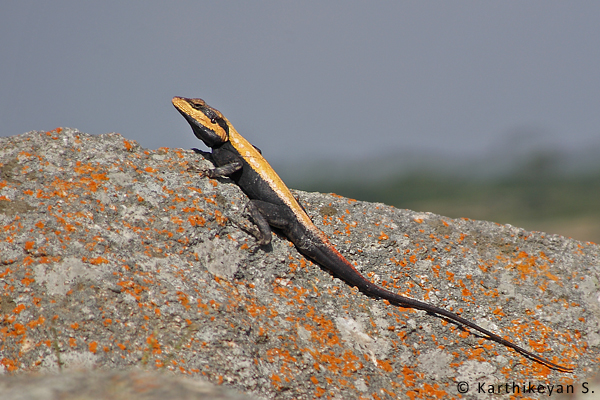
Peninsular Rock Agama – the resplendent male displaying. Females are dully coloured and camouflage well in their environs.
While its cousin, the Common Garden Lizard would sun itself sitting on a nearby bush or go about its activity in the shrubbery showing itself up from time to time. I also encountered the Checkered Keelback frequently. It was also the snake which often entered residences and caused panic among the inhabitants. I would be called to rescue the poor reptile which was possibly wondering about the pandemonium it had brought in its wake.
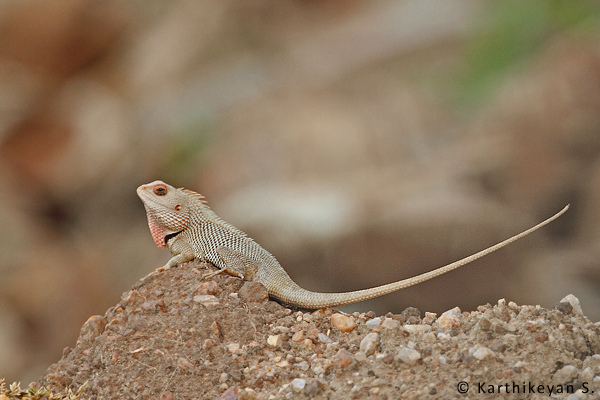
The Common Garden Lizard has made a quiet exit.
The Indian Skipper Frog Euphlyctis cyanophlyctis and the Indian Cricket Frog Fejervarya sp. were the regularly seen amphibians besides the Common Indian Toad Duttaphrynus melanostictus.
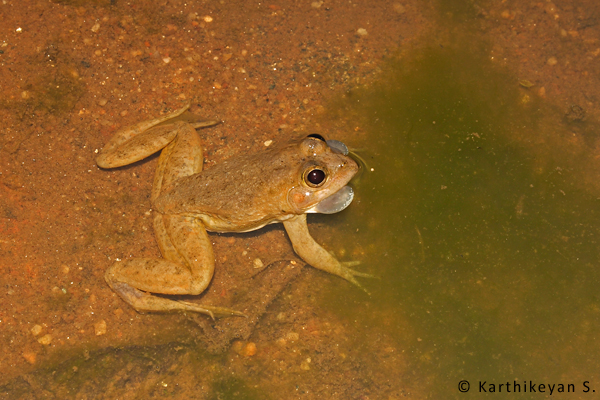
Indian Skipper Frog – another victim of habitat loss.
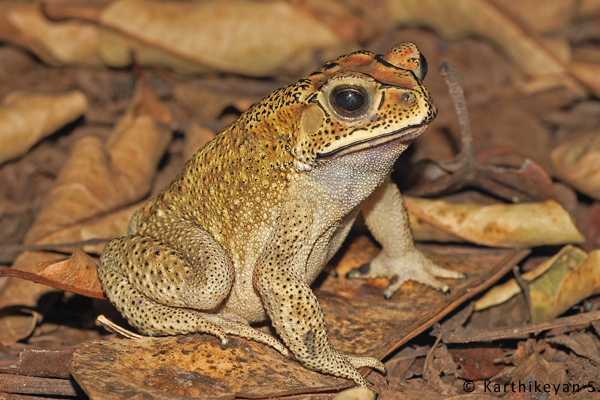
Common Indian Toad : holding on for now. Perhaps a little more ‘development’ and it may follow the Indian Skipper Frog.
The quarry has been used as a dumping ground for all kinds of waste, particularly construction debris over the years. Now, it is unsuitable for any creature to survive. The fluty notes of the Large Pied Wagtails are no longer to be heard. The munias deserted the quarry. I still hear the cackling calls of the Whitebreasted Kingfisher and the Whitebreasted Waterhen occasionally. The two frogs have almost completely disappeared while the toad seems to be barely holding on. It also has been a long time since I have seen the two lizards. Now, in the place of a lush wildlife habitat stands an apartment building!
The quarry behind my house is perhaps no exception. Several other wildlife habitats in the city, along with its various denizens, have also met with a similar fate leaving our own habitat so impoverished.